


Contemporary landscape paintings which are done in a style of surreal illusionism are for sale by David Werner of Werner Art Studios. These paintings are painted in acrylic paint that is applied primarily with an airbrush.

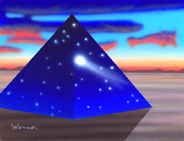

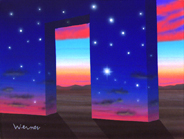
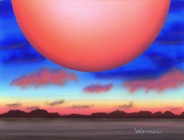
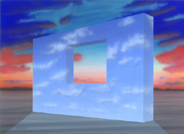
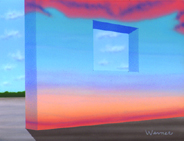

My paintings are illustrations of a moment caught in time.
All the paintings feature some sort of visual paradox: a blue
sky with a window in it, a wall composed of a sky, a midday scene
with an evening sunset in it or basic shaped objects who sometime
find it hard to stay confined to their two-dimensional realm.
My land and skies seem bright and sunny, but there is a displacing
artificiality about the too-regular clouds and flat stark planes.
The point of this interplay between drawn objects and abnormal
settings is that the common sense perception of reality is only
one way of looking at the world. I want to forcefully demonstrate
the paradoxes of perception of a given vista. As in life not all
that is perceived as being so is so. My matter-of-fact way of
depicting anomalies and incongruities in the fabric of reality
often seems to my viewers to be as humorous as it is disquieting.
Many of my paintings are laden with visual jokes, such as, does
a particular painting represent a moment caught in time within
a wall-like boundary, or is it just a spatial form representing
a static object such as a wall or sphere. Underlying the humor,
however, is a serious attempt to demonstrate the multifaceted
character of perceived reality.
In painting, space is an illusion, an indication of three dimensions
in two. This is rendered by conventions understood by the work's
audience, and conventions vary in different periods and places.
In Art this technique of illusion is called perspective it is
used to represent three-dimensional spatial relationships on a
two-dimensional surface. The three principal types of perspective
are: visual perspective, in which depth is suggested by overlapping
and by the smaller size of distant objects: linear perspective,
in which lines converge as they approach the horizon: and aerial
perspective, in which distant colors become cooler and outlines
gradually fade. In my work I emphasize the depth and projection
of objects in order to give the paintings an illusionistic quality.
Basically speaking illusionism comprises those painterly techniques
whereby forms painted on flat planes are made to appear three-dimensional
and to exist in deep space. Perspective was largely ignored until
the early 15th century, when a radically new conception of space
and form was first reflected in the art of the day. A renewed
interest in optics and mathematical laws contributed to the resources
of Perspective Illusionism. Painters everywhere took pleasure
in extreme refinements and visual trickery of various kinds. In
Italy the art of illusionism was carried to breathtaking extremes
on painted baroque ceilings.
These landscapes I paint, have their roots in a long unbroken
tradition of landscape painting in Asia. Nature oriented paintings
done in China and Japan prompted over two thousand years of landscape
art. Just as I do today, the Chinese, Japanese, and Koreans did
not "copy" nature but imagined their landscapes. These
scenes were viewed as an aid to reaching a greater spiritual enlightenment
through understanding the essence of nature. The viewer was intended
to "walk" meditatively through a terrain and contemplate
the philosophical or spiritual meanings of the elements encountered.
As in the dream landscapes paintings of the 1930's, I too mix
reality and imagination within my landscapes for a symbolic importance.
My illusionistic landscape paintings have a strong vein of surrealism
in them. This style of Surrealism in my works manifests itself
as imagery that is based on fantasy and the world of dreams. The
term surrealist was coined by Guillaume Apollinaire in 1917; the
artistic movement, however, came into being only after the French
poet Andre Breton published the first surrealist manifesto in
1924. In this manifesto Breton suggested that rational thought
was repressive to the powers of creativity and imagination and
thus hostile to artistic expression. An admirer of Sigmund Freud
and his concept of the subconscious, Breton felt that contact
with this hidden part of the mind could produce poetic truth.
In my paintings the relationship of color is of utmost importance.
Color is the sensation that is aroused when light falls on the
retina of the eye. Light may be perceived either as originating
directly from a light source or as reflected light. Color perception
depends on the different degrees to which various wavelengths
of light stimulate the eye. Color has so many meanings for different
observers that a strict definition is difficult, if not impossible.
The chemist is conscious of color as a quality concerning a pigment
or a dye; the psychologist describes color in terms of visual
perception; and the physicist may define color in terms of qualities
such as the wavelength of light and its intensity. I as the artist
however use color as a, tool to be manipulated in order to evoke
human emotion.
The paints I use are acrylic. Acrylics are water-based paints
made from acrylic resins. Since these paints appeared in the 20th
century, many painters have used them in preference to oils. Among
the many advantages of acrylics are their quick-drying properties,
durability, color fastness, and adhesion to almost any surface
I choose to paint on.
I apply the majority of my paint onto a canvas or wooden panel
using an airbrush. The airbrush is a device for applying liquid
as a fine spray. The liquid is fed into the nozzle of the airbrush
by gravity or suction, or under pressure. A flow of compressed
air atomizes the liquid into a fine mist, which is then carried
along with the air stream coming out of the nozzle. The airbrush
is designed so that normally only the supply of liquid is adjusted;
the air supply and consequently the air flow from the nozzle remain
constant. A paint spray gun is essentially a large airbrush. The
principle is similar to that of the common perfume atomizer. When
painting a work with an airbrush, the hand eye coordination is
essential in being able to "hit the mark". There is
no direct contact between the airbrush tool and the paint surface
as with a traditional paint brush. The airbrush artist does not
make direct contact with the painting but rather is several inches
away from it. Thus, he must have an intuitive knowledge as to
where the tool is pointed, in order to accurately apply the desired
amount of paint to a specific area of the painting when the airbrush's
trigger is activated.
 Werner
Studios Home Page
Werner
Studios Home Page
 Werner
Studios Animal Furniture and Home Accents Page
Werner
Studios Animal Furniture and Home Accents Page
 Werner
Studios Computer Gererated Graphics Page
Werner
Studios Computer Gererated Graphics Page


 X
X


 This site is best viewed with FIREFOX
This site is best viewed with FIREFOX